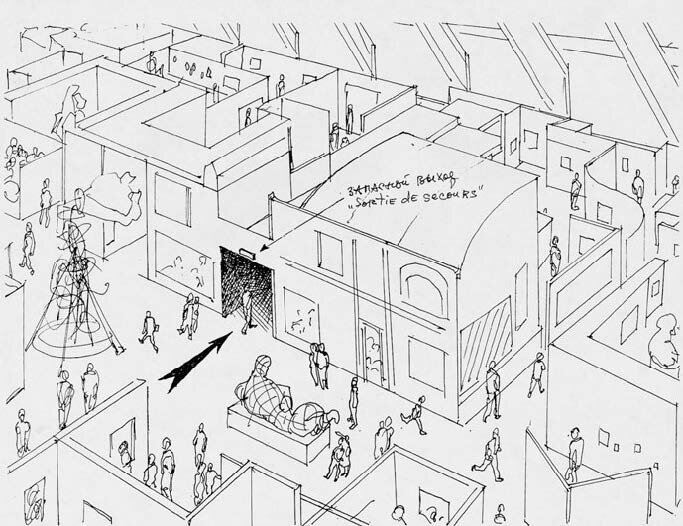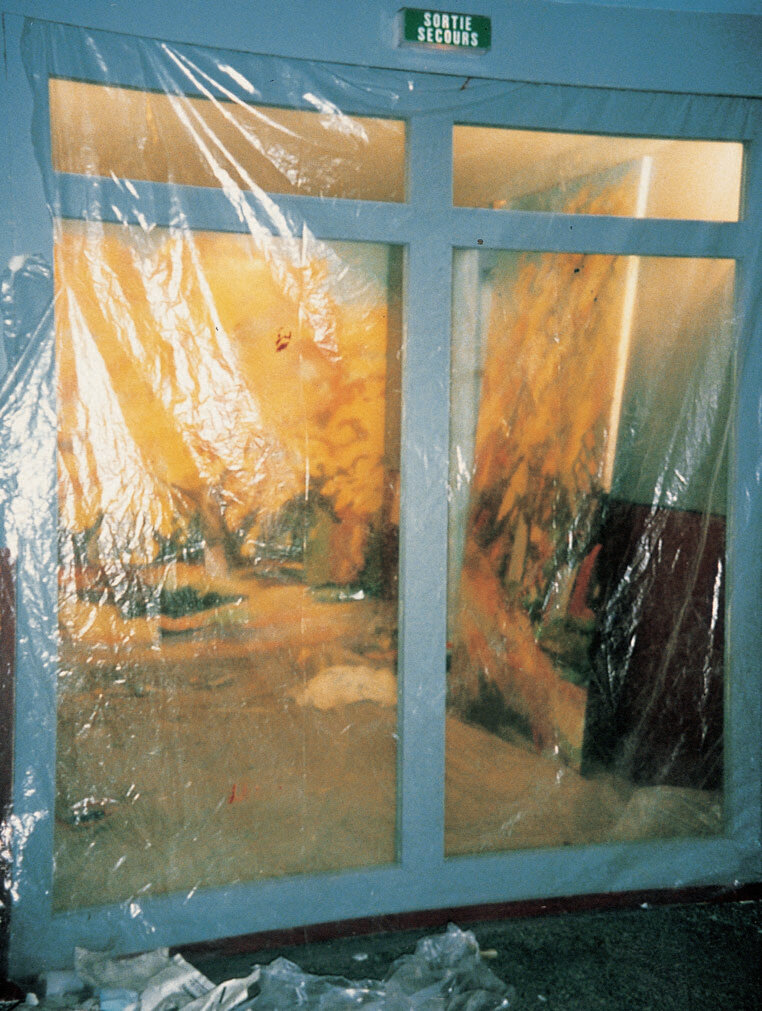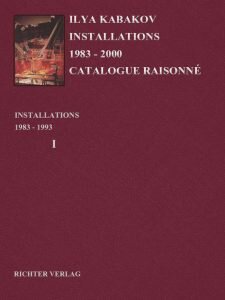Emergency Exit
YEAR: 1993
CATALOGUE NUMBER: 73
PROVENANCE
Collection of the artist
EXHIBITIONS
Lyon, Biennale D’Art Contemporain
Et tous ils changent le monde …, 3 Sep 1993 — 13 Oct 1993
DESCRIPTION
The end of the installation abuts the wall of the palace, and the entrance to the installation must be located between two pavilions or walls of the exhibition and must be located on one of the main thoroughfares through it. The installation must be covered with a ceiling along its entire length. Along both sides of the corridor leading to the main part of the installation there are 4 doors that are closed tightly. At the end of the installation, there is a door from floor to ceiling, covered in dull glass that lets light pass through but distorts the image of what is located beyond the door. On the other side of the door is a small room of the same height and width as the corridor. The three walls opposite the door are covered from floor to ceiling with a ‘painting’ depicting a landscape of an autumn garden. The ‘painting’ is done on canvas, then nailed to the wall and illuminated with bright bulbs in the corners of the room. Leaves are scattered on the floor – ‘the ground.’ Above the door is a lighted sign which reads ‘Emergency Exit.’ (There could be a problem with the fire authorities since this is a false sign, and this must be worked out ahead of time.) The ceiling is level for the entire installation, at a height of 2.45 meters. The corridor is painted: the ceiling and upper part of the walls are dark gray, the lower part of the walls to a height of 106 cm is dark brown. The doors are dark brown. The floor is not painted. There has to be a facade board above the entrance into the corridor.
Overall Dimensions of the Entire Installation
Length: 26.5 m Width of the corridor: 2.6 m
Width at the widest part (between the doors): 6.8 m
Height: 2.45 m
The ‘Illusionary’ Mechanism of the Chamber
The ‘chamber’ is a part of the corridor 270 x 400 cm that is walled off by a glass door; there are three canvasses nailed to its three walls. The canvasses hanging on the left wall (from the glass door) and on the frontal one take up the entire surface of the wall from floor to ceiling; the right one is stretched on a wooden frame and leaning up against the wall next to the ‘real’ exit leading into the interior spaces of the exhibit. (This condition was required by the fire inspectors.) Depicted on all three are ‘beautiful fall days in the park’: yellow leaves, dark trunks, long alleys, but they are drawn in three different styles: ‘fauvist,’ ‘realistic,’ and ‘Cézanne-like.’ On the floor, there are sheets of cardboard, torn paper, rags, jars with paint, brushes, turpentine. All of this is under the bright light from two bulbs attached under the ceiling in two corners.
The entire ‘atmosphere’ in this ‘chamber’ had to fulfill two functions, it had to participate in two ‘performances’ in two different roles: when the viewer enters the semi-dark corridor it appears to be a fall park bathed in sunlight; from a distance the floor has to appear like the gray ground of this park. At approximately five-six meters from the ‘door’ when approaching it, the illusion of ‘nature’ has to disappear and the viewer, walking right up to the door, is supposed to see another picture – and this is very important – an everyday picture, simple, but no less genuine. Beyond the glass is an ordinary temporary studio, a workplace that was apparently provided to the artist by the exhibit organizer so he could restore something here, paint something in his paintings before they were to be hung in the exhibition halls. The work stands along the wall and is not yet finished; he has stepped out someplace for a minute – you can see the open door into the storeroom with crates, boxes. In general, the viewer looking beyond the glass partition might get the impression that he is looking someplace he is ‘not supposed to’ and the whole incident with the ‘sunny fall day in the park’ was simply a mirage.
CONCEPT OF THE INSTALLATION
‘Too much art!’
The viewer, entering into the gigantic space of the palace of Tony Garnier, is immediately seized with horror and panic by what he sees and is expected to process: a multitude of pavilions, hundreds of walls and turns, the ideas behind the artistic works and sculptures. How can all of this be accommodated in one’s consciousness, how can one protect oneself from their influx and fleeting intrusions? (Everyone experiences this state when visiting art fairs such as FIAC, ARCO, etc.)
‘Too much art! Too many viewers!’ The natural reaction is: to slip away, get lost in a corner someplace, catch one’s breath, if only for a minute …
And here, in an interval between the walls of the pavilions a dark crevice can be seen, a desolate corridor one might turn into unnoticed and disappear from this ‘celebration of art.’ (Each person knows this desire – to escape from the loud ‘party’ and exit onto a dark balcony or into an empty, quiet room where you can finally be alone.)
The corridor is deserted, dark, and at the end, you can see a strange light. The ‘escapee’ moves toward it. Thank God, there is no work of art there.
Most likely this is an emergency exit out onto a city street, into freedom. You can quietly stand near it. Yes, this really is an ‘emergency exit’ – a broad tall door with a sign above it saying ‘Emergency Exit.’ On the other side of the dull glass door is the ground covered with leaves and the light of a quiet fall day, trees of an old garden with a golden, crown, the blue sky between the leaves …
The door, of course, is closed. But if you look at the ‘golden’ landscape behind the door carefully, then the viewer once again sees with horror and despair that this is again all constructed, that it is ‘art’: the autumn, the trees, the sky – are all drawn, all of it is specially illuminated in a room that is located behind the closed door; leaves have been scattered on the floor, and the dull glass of the door is used so that the viewer doesn’t immediately guess this deception …
Images
Literature





